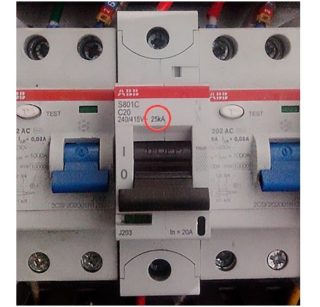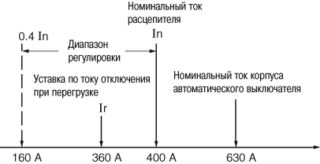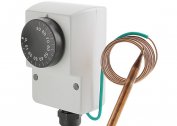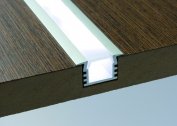Circuit breakers provide protection for consumers connected to the network in the event of a short circuit or in other emergency situations. The breaking capacity (OS) of the machine is the most important parameter that determines the preservation of functionality at high current loads. The corresponding value must be taken into account when choosing power system components.
What is the breaking capacity of a circuit breaker
The machine is installed in the power supply circuit. With an excessive increase in power consumption, the bimetallic element is heated. At a certain temperature level, a significant change in its shape breaks the contact of the conductor line.
Another protective device breaks the circuit when a strong current occurs. In addition to a short circuit, a similar reaction causes the connection of too powerful reactive load, for example, a welding machine. In a dangerous situation, the electromagnetic coil moves the circuit breaker drive mechanism.
The breaking capacity of the circuit breaker is a complex parameter. It characterizes the guaranteed performance of the basic functions of the equipment in the event of an emergency.
What OS to choose for the machine
The value of this parameter is indicated by a special color marking and a number (kA) in the lower part of the front panel. In the last century, a relatively small consumption of electricity by domestic households implied the possibility of using protective devices of 3.5 kA or less. However, these days, experienced specialists recommend choosing machines as follows:
- 4.5 kA - individual consumer groups;
- 6 kA - commissioning of apartment electricity supply;
- 10 kA - outgoing lines of the distributors of an apartment building.
Corrections are made taking into account the particular project. The increased breaking capacity of the circuit breaker (AB) is useful at a short distance to the local substation, industrial enterprises.
Rated breaking capacity AB
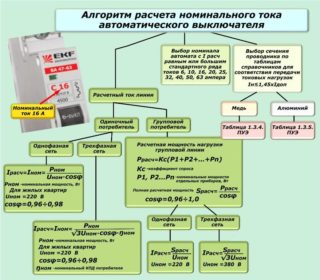 In fact, you have to take into account the features of a particular accident. The value of cos ϕ has a significant effect on the development of adverse processes. This parameter determines the energy potential of the combination of basic electrical parameters.
In fact, you have to take into account the features of a particular accident. The value of cos ϕ has a significant effect on the development of adverse processes. This parameter determines the energy potential of the combination of basic electrical parameters.
Normalize the magnitude of the current at which the machine breaks the circuit and retains sufficient functionality to perform similar actions in normal mode. It should be emphasized that the thematic standards imply a periodic component of the short-circuit current. The following notation is used for the ratings of the breaking capacity of the circuit breaker for different groups of devices based on their intended purpose:
- industrial machines - Icu (limit);
- household models - Icn (operational).
The rated breaking capacity of the circuit breaker is a basic parameter that determines the reliability of the protective device. Technological checks when performing production and certification tests are performed taking into account the rate of break of the power circuit in the relevant categories:
- A - instantly;
- B - with a set delay.
Tests are performed according to the standard program:
- simulate a short circuit followed by turning off the machine;
- check performance;
- repeat the procedure for different values of cos ϕ.
At the final stage, the compliance of the basic technical parameters with the manufacturer's passport data is clarified.
In addition to the safety of insulation, they control the reliability and speed of separation of contact groups, the absence of mechanical damage.
Ultimate Switching Capability
Current standards establish the procedure for conducting special tests. In particular, they check the preservation of operability after repeated faults. It should be understood that with the coincidence of the current vectors and voltage, the circuit is broken at a lower energy potential. In the opposite situation (cos ϕ = 0), the risk of equipment damage increases. If cos ϕ = 0.5, it is recommended to choose the maximum switching capacity of the circuit breaker with Icu in the range of 6-10 kA.
The largest operating system
The probability of the most unfavorable situation is extremely small. Typically, in the event of an emergency, short-circuit currents are significantly less than the breaking capacity of the circuit breaker (Icu). This explains the long service life of protective devices in actual operating conditions.
However, the possibility of a re-occurrence of short circuit after a short period of time after turning on the power cannot be excluded. To increase the margin of reliability, an additional parameter Ics is standardized in industrial models. The corresponding value is indicated in the accompanying documentation for the product, as% of Icu according to standard gradation:
- 25;
- 50;
- 75;
- 100.
Type tests verify the preservation of the switching capabilities of the circuit breaker after 3 cycles with open circuit after short circuit. After completion of the procedure, the correspondence of the shutdown speed and other technical parameters to the manufacturer's passport data is specified.
You will have to pay more for a high-quality machine of a famous brand. However, such products are created according to the rule of equality of Icu and Ics (100%).
Additional tests establish the actual value of the maximum current (peak level) - Icm. In this case, in addition to the signal amplitude, the rate of change of energy parameters is also of importance. In the calculation formulas, the corresponding correction factor is used, which in turn is dependent on cos ϕ.
Features AB defining OS

The study of current market offers confirms a noticeable increase in value as the disconnecting ability of the machine increases. Which model to choose will become clear after a comprehensive assessment of the project.
A device designed for a lower rating will not fulfill its functions. In a worse situation, even with a destroyed case, electrical contact will remain. The development of an emergency provokes additional breakdowns and costs.
Design features
In practice, the definition of “marginal switching resistance” is used. This indicator determines the stability of the machine to maximum loads. If a one-time PCB is indicated, then the protection will work only once. They increase the resource of technology by upgrading functional blocks. In particular, heat removal is improved to maintain structural integrity in the short circuit mode and to reduce the negative impact on contact groups.
It is recommended to pay attention to design features that simplify installation and inspection. In some models, special openings are provided for operational visual control.Be sure to take into account the proximity of transformers and other potential sources of dangerous voltage surges. The ultimate breaking capacity of the circuit breaker is chosen with a margin.
Plug loads are checked in maximum consumption modes.

